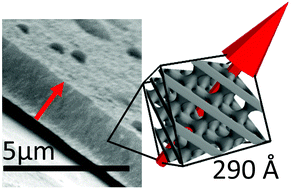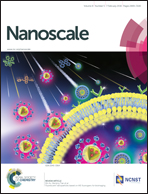Aligned platinum nanowire networks from surface-oriented lipid cubic phase templates†
Abstract
Mesoporous metal structures featuring a bicontinuous cubic morphology have a wide range of potential applications and novel opto-electronic properties, often orientation-dependent. We describe the production of nanostructured metal films 1–2 microns thick featuring 3D-periodic ‘single diamond’ morphology that show high out-of-plane alignment, with the (111) plane oriented parallel to the substrate. These are produced by electrodeposition of platinum through a lipid cubic phase (QII) template. Further investigation into the mechanism for the orientation revealed the surprising result that the QII template, which is tens of microns thick, is polydomain with no overall orientation. When thicker platinum films are grown, they also show increased orientational disorder. These results suggest that polydomain QII samples display a region of uniaxial orientation at the lipid/substrate interface up to approximately 2.8 ± 0.3 μm away from the solid surface. Our approach gives previously unavailable information on the arrangement of cubic phases at solid interfaces, which is important for many applications of QII phases. Most significantly, we have produced a previously unreported class of oriented nanomaterial, with potential applications including metamaterials and lithographic masks.


 Please wait while we load your content...
Please wait while we load your content...